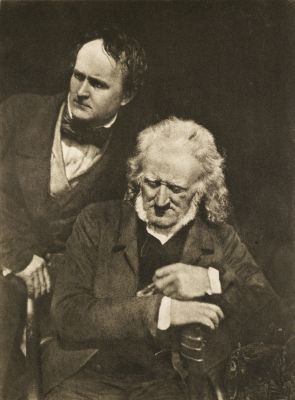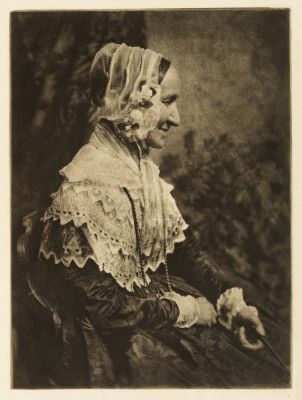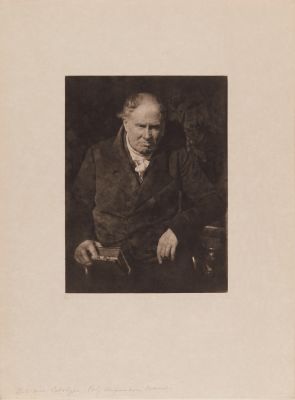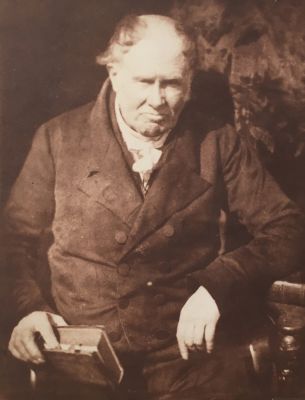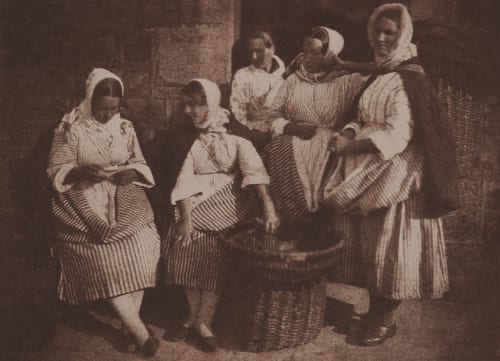
Title
Fishwomen St. AndrewsArtists
Hill, David Octavious (Scottish, 1802-1870)Adamson, Robert (Scottish, 1821-1848)Date
1845 plate (1843-1847 negative)Process
Carbon PrintAtelier
Jessie BetramImage Size
15.7 x 20.8 cm
Carbon print, printed from the original calotype negative possibly by Jessie Brown Bertram.
Photography was essentially an invention of the Industrial Revolution. By the 1840s, the adverse social and economic impact of that revolution had become painfully clear – the economic booms were followed by severe slumps; the astonishing advance and increased wealth of the nation were imbalanced by periodic destitution, by endemic disease and high mortality. The cities were crowded by incomers looking for work, and the centers of the cities were overtaken by slums. Journalists and other deeply concerned writers attempted to analyze and answer these problems.
The first photographic essay addressing such issues looked at a model of excellence – a cultured and self-determining working community – rather than at the disaster of the slums. In 1844, D. O. Hill and Robert Adamson advertised an album on The Fishermen and Women of the Firth of Forth. They took around 130 Photographs, principally on site in the fishing village of Newhaven, a mile to the north of Edinburgh, but also on the other side of the estuary in St Andrews. The organization and the number of people involved in the exercise is impressive. Some individual pictures contain up to thirty people, including restless children. The pictures show empathy between the photographers and their subjects, based on admiration for working life. With this series, Hill and Adamson invented social documentary photography, many decades before it became a practical proposition in the photographically illustrated magazines. (Stevenson)
In 1872, Archibald Burns, an established photographer who had collaborated with Hill took over Rock House, Hill & Adamsons original studio. Four years later, Alexander Inglis acquired the studio, originally operating under Burns’ name before reverting to his own. His son Francis Caird Inglis took over the business in 1904; he continued to operate Rock House until his death in 1940 and his son maintained the business until 1945. A significant amount of Hill & Adamson’s negatives and prints had remained at Rock House, and at some point Alexander Inglis or his son had Jesse Batram produce a series of carbon prints from some of the negatives, including this one. In 1941, the pioneering photohistorian and collector, Robert O. Dougan, approached Francis Caird Inglis’ widow and arranged to purchase all of the material relating to Hill & Adamson. Dougan arranged to sell the collection in its entirety to the University of Glasgow Library in 1953. (Montgomery)
Reproduced / Exhibited
Newhall, Beaumont. The History of Photography: From 1839 to the Present. , 2012. p 48 (calotype)
References
Stevenson, Sara, and A D. Morrison-Low. Scottish Photography: The First Thirty Years. , 2015. Print. P.203
Stevenson, Sara Hill and Adamson’s The Fishermen and Women of the Firth of Forth (Edinburgh: National Galleries of Scotland, 1991)
Anne Lyden, A Perfect Chemistry: Photographs by Hill & Adamson (Edinburgh: National Galleries of Scotland, 2017)
Heinrich Schwarz, David Octavius Hill, Der Meister Der Photographer, Insel-Verlag, Leipzig, 1931, pl
Stevenson, Sarah, The Personal Art of David Octavius Hill, 2002, Yale University Press, New Haven,
Bruce, David, Sun Pictures, the Hill-Adamson Calotypes, 1973, New York Graphic Society, Greenwich, CT, pg
An Early Victorian Album, Alfred A Knopf, New York, 1976,
Stevenson, Sara, David Octavius Hill and Robert Adamson, Catalogue of their Calotypes taken between 1843 and 1847 in The Collection of the Scottish National Portrait Gallery,
Roddy Simpson, The Photography of Victorian Scotland, Edinburgh University Press, Edinburgh, 2012
Sara Stevenson, Hill & Adamson’s The Fishermen and Women of the Firth of Forth, Scottish National Portrait Gallery, 1991, Edinburgh
https://www.khanacademy.org/humanities/becoming-modern/early-photo/early-photo-france/a/david-octavius-hill-and-robert-adamson-newhaven-fishwives
